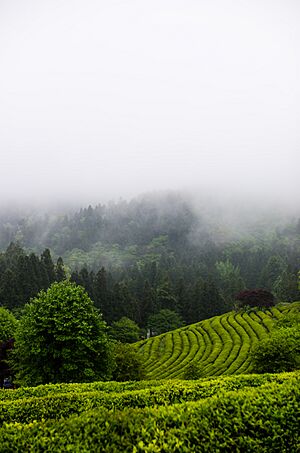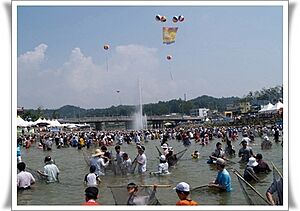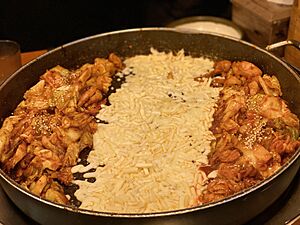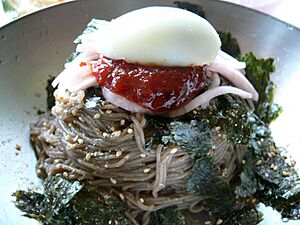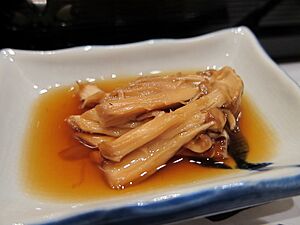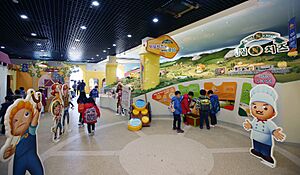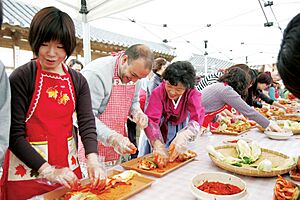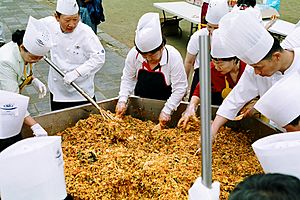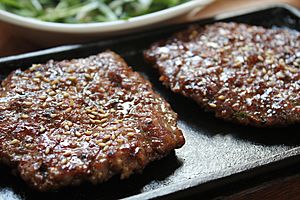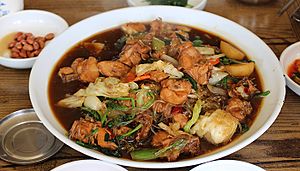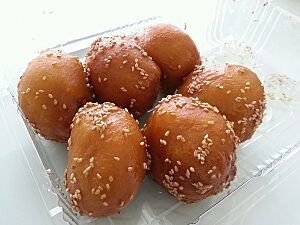Food festivals in South Korea facts for kids
The Food Festivals of South Korea are exciting celebrations. They show off Korea's delicious food and unique culture. These festivals feature everything from old traditional dishes to new, modern foods. They often use the best local ingredients from each area. These events help keep Korean culture alive, teach people about local foods, and support the Korean food industry. Some foods, like Chimaek, and the festivals themselves, have become very popular. They are even shown in K-dramas! Two famous food festivals are the Daegu Chimac Festival and the Jeonju Bibimbap Festival.
Contents
- Fun Food Festivals All Year Long
- Spring Food Festivals
- Summer Food Festivals
- Fall Food Festivals
- Geumsan Insam Festival (September-October)
- Songi Mushroom Festival (September-October)
- Jinan Red Ginseng Festival (October)
- Imsil N Cheese Festival (Beginning of October)
- Gangneung Coffee Festival (Beginning of October)
- Icheon Rice Cultural Festival (October)
- Yeoju Ogok Naru Festival (October)
- Gwangju World Kimchi Festival (October)
- Jeonju Bibimbap Festival (October)
- Hoengseong Hanu Festival (October)
- Sunchang Fermented Food Festival (October)
- Cheongsong Apple Festival (End of October - Beginning of November)
- Special Festival Food Highlights
Fun Food Festivals All Year Long
Spring Food Festivals
Boseong Green Tea Festival (May)
Every May, many visitors come to the Korean Tea Culture Park and tea plantations in Boseong-gun. Boseong is famous for its high-quality green tea. The area has perfect weather and land for growing green tea. This festival happens when the fresh green tea leaves, called haetcha (햇차), are harvested.
Visitors can enjoy many tea-themed activities. You can learn about tea ceremonies, try making tea, and even pick tea leaves yourself! There are also fun things like walking through green tea farms. You can taste food made with green tea or even try a green tea bath! Nearby places to visit include the Daehan Dawon Tea Plantation and Yulpo Seawater Green Tea Centre.
Summer Food Festivals
Daegu Chimac Festival (July)
In July, the Daegu Chimac Festival takes place at Duryu Park in Dalseo-gu, Daegu. The name "chimac" comes from "chicken" and "maekju" (a type of drink). This festival is super popular, with over a million visitors in 2016!
During the festival, Duryu Park fills with people enjoying delicious chicken and music. Artists and DJs perform outdoors. The festival starts with a special ceremony for chickens and lasts for five days. You can try chicken cooked in many different ways. Many chicken restaurants join the festival. Since it's held in summer, visitors can even enjoy their chimac in a cool footbath! Other fun events include a cooking competition and a "Chimac 99 toast time" at 9:09 PM. You can also visit nearby spots like Palgongsan Mountain and Seomun Market.
Bonghwa Eun-uh (Sweetfish) Festival (End of July)
The Sweetfish Festival is held at Naeseongcheon stream in Bonghwa-gun, Gyeongsangbuk-do. This festival offers many activities for families and friends. You can try catching sweetfish with your bare hands or with scoop nets. You can even catch them from the cool, clean Naeseongcheon stream! The fish you catch can be charbroiled (grilled over coals) to eat later. The festival also has many water sports for visitors to enjoy.
Chuncheon Dakgalbi & Makkuksu Festival (August)
Every year in August, a Dakgalbi (spicy grilled chicken) and Makguksu (buckwheat noodles) festival is held in Chuncheon. This city in Gwangwon-do is where these two dishes come from. The festival offers many fun programs. You can sample food, learn to make makguksu, and even join a makguksu eating contest!
Fall Food Festivals
Geumsan Insam Festival (September-October)
Korea is famous for its Goryeo Insam, which is Korean ginseng. The ginseng from Geumsan is especially well-known for its high quality. It has been grown there for over a thousand years! Every year, a ginseng festival is held in Geumsan in South Chungcheong province. It usually happens around Chuseok, the autumn harvest day.
At the festival, visitors can see how ginseng is grown and processed. You can learn about its health benefits through different exhibits. You can also experience the traditional culture of the community. Popular events include choosing ginseng seeds, harvesting ginseng, and trying a ginseng footbath. There are also ginseng cooking contests and traditional massages. Many visitors also go to nearby places like the Garden of Sky and Daedunsan Provincial Park.
Songi Mushroom Festival (September-October)
The Yangyang Songi Mushroom Festival is held in late September or early October. This festival lets visitors see and pick mushrooms in their natural home. Songi, or pine mushroom, is very special. It is often called a “golden mushroom” or “diamond in the tree.” Festival events include special rituals, mushroom picking, and tasting mushroom dishes. You can also try making Songcheon rice cake.
Jinan Red Ginseng Festival (October)
This festival takes place every October in the northern area of Maisan in Jinan-gun, Jeollabuk-do. Jinan is a special area in Korea known for producing Hangsam (홍삼), which is red ginseng. This festival aims to teach people about red ginseng.
At the festival, you can try high-quality red ginseng. You can also taste foods and products made with it. The festival also offers traditional experiences. These include royal martial arts shows, traditional performances, and music festivals.
Imsil N Cheese Festival (Beginning of October)
The Imsil N Cheese Festival is held at Imsil Cheese Theme Park and Imsil Cheese Village in Imsil. This town has a history of making cheese since 1958. During the event, you can find delicious foods and products made with local ingredients.
The festival has many different programs. You can try making cheese or watch cheese-themed cooking shows. There are also performances for children, an EDM party, and a night parade. Visitors often explore nearby places like Imsil Hyanngyo Confucian academy and Okjeongho Lake.
Gangneung Coffee Festival (Beginning of October)
Every fall, Gangneung in Gangwon-do hosts a coffee festival. Many famous baristas come, making it a center for coffee culture. The festival is held at the Gangneung Ice Arena and Anmok Beach.
This event is a great chance for new baristas and coffee shops. Festival activities include free coffee tasting events. There are also seminars where coffee masters share their knowledge. Contests are held for different skills like brewing, roasting, and latte art. Besides coffee, concerts and cultural events are also organized. Nearby attractions include Ojukheon House and Gyeongpo Beach.
Icheon Rice Cultural Festival (October)
Icheon in Gyeonggi province is known as the city of rice. Every fall, around late October, it hosts an agriculture festival. At this festival, visitors can taste Icheon rice. You can also experience traditional Korean farming culture. This includes threshing and planting.
There's a fairy tale section and craft making. You can join a parade or make Songpyeon (half-moon shaped rice cakes). You can also make Mujigae garaetteok (rainbow rice cake) using Icheon Rice. They even make a super long one, up to 600 meters! Other popular events include a Thanksgiving ritual and an international rice cooking contest.
Yeoju Ogok Naru Festival (October)
This festival is different because it celebrates all the produce grown in Yeoju, not just one food. Yeoju is famous for its high-quality rice, grains, and sweet potatoes. Visitors can experience different themes related to local crops. There are parties, ferry rides, and folk culture displays.
You can also get hands-on experience harvesting different produce. Then, you can use them to make various dishes, like Bibimbap (비빔밥). Visitors also go to the Ogok Jangteo market. There, you can sample and buy local Yeoju produce.
Gwangju World Kimchi Festival (October)
The Gwangju World Kimchi Festival welcomes both local and international visitors. It introduces and promotes Korea's Kimchi to people from other countries. The festival offers many different experiences, events, and a market. Special features include the Kimchi Exhibition Hall and a Kimchi Master contest. Foreign visitors especially enjoy the Kimchi making contest for foreigners.
Jeonju Bibimbap Festival (October)
In October, a festival is held at the National Intangible Heritage Centre and the Hanok village in Jeonju. Jeonju is known as the food capital of Korea. This festival celebrates Jeonju's famous dish, Bibimbap (비빔밥). Jeonju Bibimbap usually has special toppings like Jeonju soy bean sprouts and seasoned raw beef. It's served with kongnamul-gukbap (bean sprout soup).
The rice for Jeonju bibimbap is special. It's cooked in beef broth for extra flavor and finished with sesame oil. Many local cooks and famous people share their own unique versions of Bibimbap. They also offer other local dishes. A major event is making a giant Bibimbap that can feed 1000 people! There's also a cooking contest for foreigners and a "find Bibimbap" event.
Hoengseong Hanu Festival (October)
In October, the Hanu (한우, Korean beef) festival takes place in Hoengseong. This is the biggest Korean beef festival! The festival features performances, a parade, and an LED light festival. There are also fireworks and an EDM party.
There's a dining area for over a thousand visitors with barbeque spots. You can try samples and buy special dishes at good prices. Visitors can also go to nearby tourist spots like Hoengseong National SoopCheWin and Welli Hilli Park.
Sunchang Fermented Food Festival (October)
The Sunchang Fermented Food Festival is held in October. The Sunchang region is where gochujang (Korean chili paste) was first made for the royal palace during the Joseon Dynasty. This place is famous for its traditional ways of making fermented condiments, called jang. These methods are still carefully kept today.
Every fall, this festival shows off Korea's top three fermented foods. These include gochujang and other traditional condiments, Kimchi, and Jeotgal (salted and fermented seafood). You can also find Tteokbokki (stir-fried rice cakes) made with gochujang. The festival has sixty different programs. These include hands-on activities, cultural performances, and exhibitions. There are craft-making programs for kids and markets where you can buy traditional fermented condiments.
Cheongsong Apple Festival (End of October - Beginning of November)
In the fall, the Cheongsong Apple Festival is held in Cheongsong-gun, Gyeongsang province. This festival celebrates the apple harvest and offers hands-on experiences. The festival also has unique games like "Finding the Golden Apple." You can make apple jam by joining "Apple Nanta." There are also parades, sports events, and a masquerade.
Special Festival Food Highlights
Many festivals in South Korea attract lots of visitors. Locals often use these events to show off their best local foods and unique treats. Here are some special Korean foods you might find at well-known festivals:
- Suwon Galbi from Suwon Hwaseong Cultural Festival is grilled seasoned beef ribs.
- Hodugwaja from Cheonan World Dance Festival is a baked walnut pastry with sweet red bean paste.
- Tteokgalbi from Damyang Bamboo Festival is a dish made with beef. The marinated beef is grilled with vegetables and often eaten with steamed rice.
- Heukdwaejigugi from Jeju Fire Festival is a grilled dish. It's made with local black pork from Jeju, known for its good marbling and thin fat.
- Chuncheon Dakgalbi from Chuncheon International Mime Festival is a stir-fried dish. It's made with chicken, vegetables, and a special spicy sauce cooked on a large iron plate.
- Andong Jjimdak from Andong Mask Dance Festival is a local sweet, salty, and savory dish. It's made with soy sauce marinated chopped chicken, shiitake mushrooms, potatoes, and dried red chili.
- Maeungalbijjim from Daegu Yangnyeongsi Herbal Medicine Festival is steamed pork. It's cooked with a sweet and spicy sauce, a little soupy base, and pepper flakes. You can also find this dish at the Daegu Chimac Festival.
- Dwaejigukbap from Gwangalli Eobang Festival is a soup made with pork broth and steamed rice.
- Kkulppang from Tongyeong Hansan Battle Festival is also known as honey bread. It's a sticky, sweet bread traditionally filled with sweetened red bean paste. It has a coating of Korean grain syrup, jocheong (조청).


